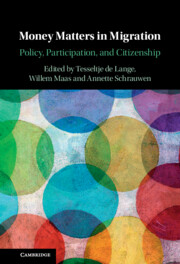Book contents
- Money Matters in Migration
- Money Matters in Migration
- Copyright page
- Contents
- Notes on Contributors
- 1 Money Matters in Migration: A Synthetic Approach
- Part I Migration
- 2 The Changing Landscape of Multilateral Financing and Global Migration Governance
- 3 Digging a Moat around Fortress Europe: EU Funding as an Instrument of Exclusion
- 4 The “Refugee Hospital”. Aid Money, Migration Politics, and Uncertain Care in Neoliberal Morocco
- 5 Cash Rules Everything: Money and Migration in the Colombian-Venezuelan Borderlands
- 6 Recruitment Fees, Indebtedness, and the Impairment of Asian Migrant Workers’ Rights
- 7 Pushing Out the Poor: Unstable Income and Termination of Residence
- 8 Follow the Money: Income Requirements in Norwegian Immigration Regulations
- Part II Participation
- Part III Citizenship
- Index
- References
5 - Cash Rules Everything: Money and Migration in the Colombian-Venezuelan Borderlands
from Part I - Migration
Published online by Cambridge University Press: 12 November 2021
- Money Matters in Migration
- Money Matters in Migration
- Copyright page
- Contents
- Notes on Contributors
- 1 Money Matters in Migration: A Synthetic Approach
- Part I Migration
- 2 The Changing Landscape of Multilateral Financing and Global Migration Governance
- 3 Digging a Moat around Fortress Europe: EU Funding as an Instrument of Exclusion
- 4 The “Refugee Hospital”. Aid Money, Migration Politics, and Uncertain Care in Neoliberal Morocco
- 5 Cash Rules Everything: Money and Migration in the Colombian-Venezuelan Borderlands
- 6 Recruitment Fees, Indebtedness, and the Impairment of Asian Migrant Workers’ Rights
- 7 Pushing Out the Poor: Unstable Income and Termination of Residence
- 8 Follow the Money: Income Requirements in Norwegian Immigration Regulations
- Part II Participation
- Part III Citizenship
- Index
- References
Summary
Since 2015, over five million Venezuelans have fled their country in an attempt to survive the near collapse of the country’s economy. A majority of these migrants have relocated to geographically proximate countries in Latin America, and as such, millions have been forced to transit through the Colombian–Venezuelan borderlands in order to arrive at their final destination. Extending from the Amazon to the Caribbean, this vast binational region plays host to a myriad of state and armed non-state actors who compete and collaborate for control of resources, people, and territory. Money plays an important role for Venezuelan migrants who transit through or settle in the borderlands. Their access to money, or lack thereof, dictates how and where they enter, transit through, and ultimately settle in Colombia or beyond. Even for those migrants lacking financial any meaningful resources, both Colombian and Venezuelan authorities and other armed non-state actors in the borderlands have found a variety of ways to regulate, victimize, and profit from their entry, settlement, and incorporation into local informal economies.
- Type
- Chapter
- Information
- Money Matters in MigrationPolicy, Participation, and Citizenship, pp. 74 - 92Publisher: Cambridge University PressPrint publication year: 2021



